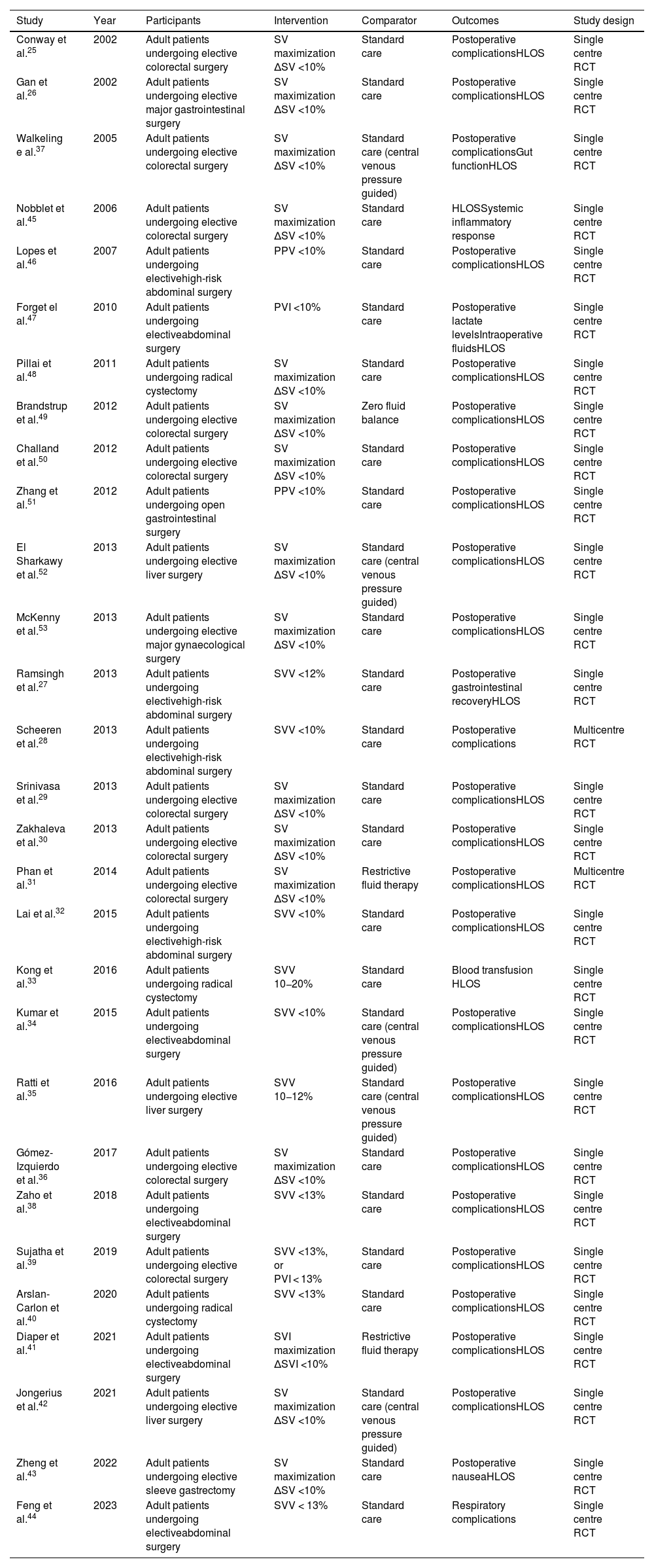To evaluate the clinical impact of optimizing stroke volume (SV) through fluid administration as part of goal-directed hemodynamic therapy (GDHT) in adult patients undergoing elective major abdominal surgery.
MethodsThis systematic review and meta-analysis was conducted in accordance with the Preferred Reporting Items for Systematic Reviews and Meta-Analyses (PRISMA) statement and was registered in the PROSPERO database in January 2024. The intervention was defined as intraoperative GDHT based on the optimization or maximization of SV through fluid challenges, or by using dynamic indices of fluid responsiveness, including stroke volume variation, pulse pressure variation, and plethysmography variation index compared to usual fluid management. The primary outcome was postoperative complications. Secondary outcome variables included postoperative acute kidney injury (AKI), length of stay (LOS), intraoperative fluid administration, and 30-day mortality.
ResultsA total of 29 randomized controlled trials (RCTs) met the inclusion criteria. There were no significant differences in the incidence of postoperative complications (RR 0.89; 95% CI, 0.78–1.00), postoperative AKI (OR 0.97; (95% IC, 0.55–1.70), and mortality (OR 0.80; 95% CI, 0.50–1.29). GDHT was associated with a reduced LOS compared to usual care (SMD: −0.17 [−0.32; −0.03]). The subgroup in which hydroxyethyl starch was used for hemodynamic optimization was associated with fewer complications (RR 0.79; 95% CI, 0.65–0.94), whereas the subgroup of patients in whom crystalloids were used was associated with an increased risk of postoperative complications (RR 1.08; 95% CI, 1.04–1.12).
ConclusionsIn adults undergoing major surgery, goal-directed hemodynamic therapy focused on fluid-based stroke volume optimization did not reduce postoperative morbidity and mortality.
Evaluar el impacto clínico de optimizar el volumen sistólico (VS) mediante la administración de líquidos como parte de una terapia hemodinámica guiada por objetivos (THGO) en pacientes adultos sometidos a cirugía abdominal mayor electiva.
MétodosEsta revisión sistemática y metaanálisis fue realizada de acuerdo con la declaración PRISMA (Preferred Reporting Items for Systematic Reviews and Meta-Analyses), y fue registrada en la base de datos PROSPERO en enero de 2024. La intervención fue definida como THGO intraoperatoria basada en la optimización o maximización del VS mediante retos de fluidos, o mediante el uso de índices dinámicos dmen sistólico, la variación de la presión de pulso y la variación del índice pletismográfico, en comparación con el manejo de líquidos habitual. El resultado primario fueron las complicaciones postoperatorias. Las variables del resultado secundario incluyeron insuficiencia renal aguda (IRA) postoperatoria, estancia hospitalaria postoperatoria (EHP), administración de líquidos intraoperatoria, y mortalidad a 30 días.
ResultadosUn total de 29 ensayos controlados aleatorizados (ECAs) cumplieron los criterios de inclusión. No se observaron diferencias significativas en cuanto a la incidencia de complicaciones postoperatorias (RR 0,89; 95% IC, 0,78 a 1), IRA postoperatoria (OR 0,97; (95% IC, 0,55 a 1,70), y mortalidad (OR 0,80; 95% IC, 0,50 a 1,29). La THGO estuvo asociada a una reducción de la EHP, en comparación con los cuidados habituales (DME: −0,17 [−0,32; −0,03]). El subgrupo en que se utilizó hidroxietil-almidón (HEA) para optimización hemodinámica estuvo asociado a menores complicaciones (RR 0,79; 95% IC, 0,65 a 0,94), mientras que el subgrupo de pacientes en los que se utilizaron cristaloides estuvo asociado a un incremento del riesgo de complicaciones postoperatorias (RR 1,08; 95% IC, 1,04 a 1,12).
ConclusionesEn los adultos sometidos a cirugía mayor, la terapia hemodinámica guiada por objetivos dirigida a la optimización del volumen sistólico con líquidos no redujo la morbilidad y mortalidad postoperatorias.
Artículo
Comprando el artículo el PDF del mismo podrá ser descargado
Precio 19,34 €
Comprar ahora












